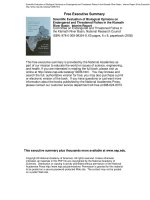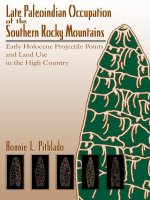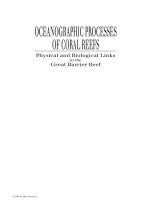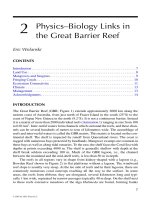bodies of difference experiences of disability and institutional advocacy in the making of modern china
Bạn đang xem bản rút gọn của tài liệu. Xem và tải ngay bản đầy đủ của tài liệu tại đây (2.7 MB, 305 trang )
TeAM
YYePG
Digitally signed by TeAM YYePG
DN: cn=TeAM YYePG, c=US,
o=TeAM YYePG, ou=TeAM
YYePG, email=
Reason: I attest to the accuracy
and integrity of this document
Date: 2005.08.18 15:00:02
+08'00'
Bodies of Difference
Hand-crank tricycles mark a gathering of the Beijing Disabled Youths Club at the home of a
former club member, mid-1980s. Anonymous photo.
Bodies of Difference
Experiences of Disability and Institutional
Advocacy in the Making of Modern China
Matthew Kohrman
UNIVERSITY OF CALIFORNIA PRESS
Berkeley Los Angeles London
University of California Press
Berkeley and Los Angeles, California
University of California Press, Ltd.
London, England
© 2005 by the Regents of the University of California
Library of Congress Cataloging-in-Publication Data
Kohrman, Matthew, 1964–.
Bodies of difference : experiences of disability and institutional
advocacy in the making of modern China / Matthew Kohrman.
p. cm.
Includes bibliographical references and index.
ISBN 0-520-22644-5 (cloth : alk. paper)—ISBN 0-520-22645-3
(pbk. : alk. paper)
1. People with disabilities—China. 2. Biopolitics—China.
I. Title.
HV1559.C6K64 2005
362.4'0951—dc22 2004005279
Manufactured in the United States of America
13 12 11 10 09 08 07 06 05
10987654321
Printed on Ecobook 50 containing a minimum 50% post-consumer
waste, processed chlorine free. The balance contains virgin pulp,
including 25% Forest Stewardship Council CertiWed for no old
growth tree cutting, processed either TCF or ECF. The sheet is
acid-free and meets the minimum requirements of ANSI/NISO
Z39.48– 1992 (R 1997) (Permanence of Paper).8
For Asa and Ezra
CONTENTS
List of Illustrations / viii
Preface / ix
Acknowledgments / xv
Introduction
/
1
1. A Biomythography in the Making
/
31
2. Why Ma Zhun Doesn’t Count / 57
3. Building a Corporeal Corporate Body / 83
4. Speeding Up Life in Beijing
/
113
5. Troubled Sociality: The Federation-Canji Relationship
in Wenchang County / 144
6. Dis/ablement and Marriage: Ridiculed Bachelors,
Ambivalent Grooms / 171
Epilogue / 200
Notes / 215
Appendix a / 245
Appendix b / 251
References / 255
Index / 275
ILLUSTRATIONS
viii
1. Deng Pufang as an adolescent watching CCP luminaries / 39
2. Main ofWce of metropolitan Beijing Disabled Persons’
Federation / 93
3. Disability symbolism, a rare sight in the 1990s / 107
4. A snowy day in Beijing / 133
5. Employee of the Xuan Wu District Disabled Persons’ Federation repairs
his mototrike / 135
6. Keeping track of the community / 145
7. Married Wenchang County residents playing majiang / 187
8. On the move / 195
9. “Wheelchair-bound Deng Pufang . . .” / 205
PREFACE
ix
In the summer of 1998 I spent a week in Beijing. The highlight of that
warm-weather visit was not the anthropological conference I was attending
at Beijing University, nor the interview that I conducted with an ofWcial from
whom I had long sought an audience. The most meaningful aspect of the
week, for me, was the lunch I had with a dozen people, mostly men, whom
I had befriended in the mid-1990s, when I had conducted the major por-
tion of the research for this book.
One of these friends was Hai Jun.
1
Hai had picked me up at the Beijing
Drum Tower subway station, and once we had cleared the tangle of bicycles
parked around the tower, we motored for about a mile to our destination,
a Shandong restaurant, weaving through back streets Wlled with sundry vehi-
cles, potholes, and pedestrians. Two years had passed since I had last been
in Hai Jun’s city, or upon his motorcycle, and it seemed to me that the few
pedestrians who bothered to even look up as we drove past were far less
attentive to the sight of us. Have things changed that much in my absence?
I wondered. When I had Wrst visited China in the 1980s, my tall, Euro-
American persona had frequently been the object of signiWcant stares, even
in cosmopolitan centers like Beijing. And when Hai had begun giving me
rides through the capital city in 1994, many people would gawk at the sight
of two men riding on a three-wheeled motorcycle, one of them an obvious
polio survivor and the other an obvious foreigner. It was the odd combina-
tion of our alterity (sociopolitically mediated otherness) and our bodiliness
(sociopolitically mediated body-self) that no doubt had caused many to stop
and stare. But on this day in 1998 it seemed to me that we hardly attracted
attention at all.
Hai parked in front of the restaurant next to a group of similarly de-
signed motorized tricycles and then he quipped over his shoulder, “Looks
like everyone else is here.” After being seated in a pre-reserved dining room,
we all settled into our table activities, slowly eating an array of meats, veg-
etables, and grains, commenting on the dishes one by one, and chatting
about a variety of topics, some humorous, some more disturbing.
Hai Jun briefly discussed a weightlifting class he was contemplating tak-
ing. The woman to my right described recent battles she and her “crippled”
business partner, as she referred to him, had been having with the tax col-
lectors. I reported on recent events in my own life and received a fair
amount of teasing about still not having completed this book despite being
so seemingly “able-bodied” (jianquan), as one friend noted. Two dining
companions regaled the rest of us with wry details about a karaoke party
they had attended that had been sponsored by China’s nationwide disabil-
ity advocacy organization, the Disabled Persons’ Federation. And the man
seated across from me, an employee of the Federation for the previous six
years, talked with biting wit about changes in policies and personnel within
the institution.
Shortly before the meal’s end, I mentioned my earlier surprise at the fact
that Hai and I had elicited so little attention as we had zigzagged our way to
the restaurant. Several minutes of discussion ensued, and then, being that
he was our host, Hai took it upon himself to sum up what he understood to
be the group’s overall view:
Yes, you could say, in recent years here in Beijing, people like us have experi-
enced transformations similar to dabizi [“longnoses,” a Mandarin Chinese
term used to code people of Euro-American descent, who are not citizens of
the People’s Republic of China]. Just think of what life was like during the Wrst
decade after the Cultural Revolution. Foreigners were still a rarity outside of
the diplomatic and university districts, and most of us around this table spent
nearly all our time as hermits cooped up at home. We quezi [crippled] were
invisible because we hid ourselves away. That’s no longer the case. We’re out
on the streets going where we want to go. The world is talking about the dis-
abled now. And the Federation has been telling everyone about us. So, now
we’ve become known. We’re canji ren. In that way, like foreigners over the last
few years, we’ve become a part of modern life here in Beijing. Now, most
Beijingers expect to see and hear about people like you and me, about for-
eigners and canji. That means they have come to develop expectations about
what we do, what we say. It also means, oddly, that we’ve become somewhat
invisible again. That’s particularly the case with us canji because most people
in this city prefer not to think about us. Doing so makes them feel guilty for
how terribly we’re treated and it frightens them that, they too, could have bod-
ies like us.
2
This book pertains to bodiliness, alterity, and the lives of a large number of
people who reside in the People’s Republic of China (PRC). While self-reflex-
ivity has become a valuable part of my scholarly discipline, anthropology, and
x preface
while aspects of my own positionality have been important for the production
of this book, the alterity that primarily animates this study is not that of “for-
eigner” (waiguo ren). Rather, it is a different otherness, a different piece in
modernity’s order of things—one certainly shaped by processes deWning for-
eignness in recent years across China, but one that has come to carry very dif-
ferent meanings and signiWcance—that is of central concern here.
This book discusses an embodied form of otherness that, over the last two
decades, has become increasingly important to many people in China and
that, over this period, has become a subject of increasing public attention.
The otherness that comprises the focus in this text is what Mandarin speak-
ers in China increasingly refer to as canji [pronounced “tsan-jee”] and what
more and more English speakers around the world refer to as “disability.”
Several questions about canji are attended to here. On a relatively broad
level, these questions include: In 1980s and 1990s China, how did people
become subject to new kinds of knowledge production and distinctive
identiWcation having to do with canji? Why did canji, a hitherto rarely used
term in China, get mapped onto the English category “disability” and
emerge in the PRC as a topic of signiWcant meaning-making at the end of
the twentieth century, something about which books were published, arti-
cles written, Wlms produced, and professional disciplines established? Why,
in the 1990s, did groups of people—people like Hai Jun and several of the
other male dining partners at the Shandong eatery—begin to self-identify
as canji and to spend a considerable amount of time together, thereby cre-
ating for themselves new social spaces? Why, in some cities, were men who
had difWculty in walking particularly inclined to develop what they some-
times called “disability circles” and “disability brotherhoods”—associations
that afforded their members everything from audiences for storytelling, to
trusted shoulders upon which to lean, introductions for sexual encounters,
partnerships for businesses, to collaborators for acts of public deWance, and
interpersonal intimacy that promoted greater self-understanding?
In addressing these questions, this book is designed to draw our attention
to the ways that canji has been emerging and metamorphosing in China as
a social, political, and somatic sphere of existence in recent decades. How-
ever, it must be emphasized that this book is about more than how a speciWc
social category, canji, was constructed in late-twentieth-century China, or
how a sizable number of men used the term canji to map their own suffer-
ing, palliation, sociality, and self-making.
This book is also about the production of a new state bureaucracy within
a national and international context. In particular, it is about the production
of the speciWc bureaucracy that my dining companions and I discussed on
that summer afternoon as we enjoyed the flavors so distinctive to Shandong
cuisine. Throughout this book, I focus extensively on the formation of that
organization, an institution which, within only a decade, became a vice-
preface xi
ministry in the People’s Republic’s governmental apparatus. This is the
China Disabled Persons’ Federation (zhongguo canjiren lianhehui). Founded in
March 1988 with great fanfare by the Chinese and international media, the
China Disabled Persons’ Federation has three formal objectives: to represent
the common interests of all Chinese citizens with disabilities, to protect their
legal rights and interests, and to mobilize social forces to serve them.
How and why did an institution like the Federation surface just as China
was emerging from three decades of Maoism? How, in the rapidly changing
nation-state that was late-twentieth-century China—a country ruled by com-
munist imprimatur yet increasingly engaged with the forces of transnation-
alism and neoliberal economics—were resources marshaled and directed
into the development of a governmental disability-advocacy organization?
Why, at the end of the 1980s, did China’s party-state launch an organization
that was speciWcally devoted to helping those citizens it identiWed as disad-
vantaged by virtue of the conflict between the demands of everyday life,
morally infused perceptions of normality, and biomedically deWned dys-
functional bodies? Why, in the 1980s and 1990s, when China’s government
was in the midst of dismantling many of its erstwhile socialist guarantees,
would the party-state choose to foster an institution for the disabled, one
charged with creating welfare mechanisms, social service personnel, laws,
media, and medical interventions? Moreover, how did the Federation grow
so quickly? How is it that by the late 1990s, a decade after its founding, the
Federation had ofWces located in tens of thousands of China’s townships,
county seats, and city neighborhoods?
By raising these questions here, in the book’s Preface, I wish to empha-
size, as already noted, that this book is as much about the formation of state
bureaucracy (the creation of the Federation) as it is about the formation of
embodied otherness (the framing of canji as lived experience).
How are we to examine these two domains of sociopolitical formation?
How are we to analyze, on the one hand, the development of a new gov-
ernmental agency and, on the other hand, a transforming and expanding
sphere of difference? Should our method be that of a compartmentalizing
clinician, wherein we analyze one of these limbs Wrst, then move on to dis-
sect its opposite member, making believe that at any given moment one
appendage is missing or that its prosthetic is out for repair?
A central tenet of this book is that these two aspects of sociopolitical for-
mation need not be investigated separately and that, in fact, there is much
to be learned by examining how the two interact—or to extend the somatic
metaphor further, how they work hand-in-hand. Indeed, a central argument
of this book is that there is a great deal to be gained, analytically, and to a
certain degree, sociopolitically, by examining how and why governmental
bureaucracies and alterity may be mutually constitutive within and across
social and historical contexts.
xii preface
Toward these ends, the lines of inquiry persistently present in this text
are purposely designed to fuse many of the questions already posed above.
These integrated lines of inquiry can be articulated as follows: How is it that,
at the end of the twentieth century, some people’s bodies in the PRC
became the loci for sizable sociopolitical formation, both governmental and
experiential? In the 1980s and 1990s, how were such people central to the
development of China’s Disabled Persons’ Federation and, by extension, to
China’s party-state? Conversely, how did this newly emerging branch of the
party-state, the Federation, help deWne canji as a biomedically grounded
state of existence, how did it influence how people responded to canji with-
in community contexts, and how did it shape the ways, for some, canji would
be lived? In what ways did the overlap of these two spheres of sociopolitical
formation become dependent upon and disruptive to the historical trajec-
tory of more overarching modes of organization in China (e.g., state con-
trol, patriarchy, and ableism)? And, Wnally, how were these spheres of
sociopolitical formation especially contingent upon the interplay of addi-
tional founts of modernism at the end of the twentieth century, like human-
itarian internationalism, empiricism, and capital expansion?
This is a unique menu, no doubt one that will satisfy the palates of some
readers while leaving others less sated. At the end of the Shandong lunch
that Hai Jun hosted, the sole woman at the table, Wang Xiaoping, teased
Hai Jun about the array of dishes he had ordered, which, while adequate in
number, she said, were somewhat lacking since the balance between meats,
vegetables, and grains did not follow common banqueting convention. And
then she quipped, “Hai, you’re such a capable canji, but still you don’t know
how to order at a restaurant. Maybe, instead of taking that weightlifting
course, instead of trying to become a more modern man, you could con-
vince the Federation to provide you a rehabilitation course in banqueting.”
Hai retorted:
Wha! I don’t need anything more to be a modern man [xiandai nanzihan].
Maoism has faded and the Federation has become my big uncle [dashushu].
I’m quite the modern man now. I’ve had corrective polio surgery three times.
I’ve launched my own canji business. I may even go to Australia next year as a
member of a Federation delegation. If you wanted a conventional menu
today, you should have provided me a more conventional set of companions.
What’s conventional about you and everyone else here—a foreign anthro-
pologist and a bunch of disabled men like me? Give me a more conventional
guest list, and I’ll provide a more conventional array of dishes.
In order to disentangle some of the unique processes underlying my
“unconventional” dining companions’ barbs, I hope you will recognize the
need for this book to provide a likewise distinctive if not unconventional
anthropological feast.
preface xiii
xv
There is an insight about sentience that I Wrst heard described a few years
ago. It has to do with pain. It goes like this. You can share a space with one
or more people, sit only inches away from them, even listen to them talk
about topics in great detail, and be unaware that any one of them is in a
state of utter agony.
Cannot the same be said about other forms of sentience, though? For
instance, cannot the same be said for gratitude?
Before you become absorbed in the topics of this book in any great
detail, before you become rooted in the textual spaces that comprise this
volume, I would like to divulge something about the sentiments that ani-
mate what you will be reading here. This admission is not that my ethnog-
raphy arises in part from the suffering of people with whom I have carried
out research over the last decade. That is obvious, or will be soon enough.
Rather I want to make it clear that this book’s every line is underlain by debt
and appreciation.
And toward that end, there is a dizzying array of friends and allies who
deserve acknowledgment. To all those who helped me in China during my
Weldwork, duo xie (many thanks)! Thank you for assisting me, thank you for
sheltering me, and thank you for putting up with my inquiries over the
years. Some of you who deserve special recognition here and who I can
identify by name (alas, many I cannot because of the need for anonymity)
are Gao Xiaorui, Wei Maoguo, Li Qiang, Chen Wen, Lin Daodan, Geng Jun,
Willie Brent, Susan Lawrence, and Chen Yu, as well as Michael Phillips, Sing
Lee, Veronica Pearson, Han Feng, and Li Shizhuo. My deepest appreciation
and affection goes out to everyone in Min Song, particularly the Chen fam-
ily for welcoming me into their home, taking me for starlit canoe rides, and
teaching me so much about the intimacies of everyday life.
Here in the United States, there are three mentors and friends who
are due special acknowledgement. These are James L. Watson, Arthur
Kleinman, and Michael Herzfeld. Without their support, attention to detail,
and astute advice, this book may never have been produced. For sure, it
would not have developed into its current form. Others who helped inform
key conceptual foundations of this ethnography over the years are current
and former participants in Harvard’s Friday morning medical anthropology
seminar and members of Harvard’s Department of Social Medicine.
Especially notable people in this regard are Mary-Jo DelVechio Good, Joe
Dumit, Byron Good, Karen-Sue Taussig, João Biel, Jean Jackson, Cheryl
Mattingly, Paul Farmer, and Bob Desjarlais.
Many more friends and colleagues—whether now living in the U.S.,
China, or elsewhere—are likewise owed words of gratitude for peppering
me not simply with keen suggestions and critique on segments of this study,
but also, just as importantly, encouragement and good humor. These
include many of my former doctoral classmates, like Lida Junghans, Jing
Jun, Julie Goldman, Jeanne Shea, Maris Gillette, Maya Todeschini, Matthew
McGuire, Lindsay French, Fuji Lozada, Yan Yunxiang, John Fox, Lawrence
Cohen, Narquis Barak, John Gerry, and Komatra Chuengsatiansup.
Also to be mentioned are Suzanne Gottschang, Liu Xin, Lisa Rofel, Gail
Hershatter, Ken George, Sandra Hyde, Judith Farquhar, Susan Greenhalgh,
Hugh Gusterson, Tanya Luhrmann, Adriana Petryna, Paul Longmore, Zhang
Li, Emily Martin, Myron Cohen, Benedicte Ingstad, Linda Mitteness, Andrew
Walder, Susan Brownell, Rayna Rapp, Ezra Vogel, Jean Oi, Begonia Aretxaga,
Philippe Bourgois, Jay Dautcher, Ann Anagnost, Russell Shuttleworth,
Vincanne Adams, Nancy Chen, and Rubie Watson. Thank you all for respond-
ing to sections of this study, providing feedback to materials presented at con-
ferences, or simply pausing in the midst of your busy lives to buoy my conW-
dence about this project.
Margery and Lee Kohrman are due my most heartfelt appreciation for
providing me the encouragement, nurturance, and nerve to drift off
through scholarly lands. Many thanks go out to my colleagues in CASA—
the Department of Cultural and Social Anthropology at Stanford—for
extending their warmth, for creating such a vibrant intellectual space here
in California, and for helping me Wnd my footing in recent years on this
sometimes shaky edge of the PaciWc. I would also like to express special
thanks to current and former graduate students at Stanford working in the
terrains of medical anthropology and cultural studies of science, with whom
I have had the good fortune to interact and who have repeatedly con-
tributed to my thinking. These include Mei Zhan, Jennifer Chertow, Julia
Carpenter, Miriam Ticktin, Tiffany Romain, and Sarah Ramirez.
Financial support for this project was provided by grants from the Com-
mittee on Scholarly Communication with China, Harvard University’s
xvi acknowledgments
Sinclair Kennedy Traveling Fellowship, the National Institute of Mental
Health, the Chiang Ching Kuo Foundation, the Mellon Foundation, the
Hoberman Fund, and the Foreign Language and Area Studies Program.
Gratitude is duly owed Ravneet Kar for proofreading sections of this
book as they neared Wnal stages of completion. Some materials of this book
have appeared in four journals: Medical Anthropology Quarterly, Cultural
Anthropology, American Ethnologist, and Culture, Medicine, and Psychiatry. My
thanks to the editors of those journals and to their anonymous readers for
pushing me to clarify my ideas. I am also grateful to all those at University
of California Press who have worked on this text and repeatedly awed me
with their patience and professionalism, most notably Sheila Levine, Reed
Malcolm, and Ruth Steinberg.
More than anyone else, though, I wish to express my ongoing apprecia-
tion to Amy Kohrman. Since that blustery December day we met in a garage
along the northern bank of the Charles River, you have provided me the
conWdence to weather long periods of intellectual doubt. You have helped
discipline my disheveled prose. And you have embraced me with your
unmatched love and levity.
acknowledgments xvii
1
THE FALL
One day in the spring of 1968, a body dropped from a third-floor window
at Beijing University. On the way down, it bounced off a steel guide wire,
flipped, and thudded to the ground. A crowd of people quickly congre-
gated. At Wrst, no one did anything except look at the young man and point
toward the window of the physics building from where he fell. Moments
later, the twenty-four-year-old man regained consciousness and began to call
to those around him for medical treatment. Still, nobody came to the man’s
aid. As is the case in many urban settings around the world, indifference to
the plight of strangers has and continues to occur in the cities of China, but
in this instance nearly everybody knew the injured man. He was a classmate.
Eventually, some people stepped forward. They carried the student, who
was in acute pain and experiencing complete paralysis in his lower extrem-
ities, to the university clinic. Medical personnel blocked them from carrying
the man into the clinic, however. The rescuers then decided to transport the
student off campus to the emergency ward of the nearby Beijing Medical
College (BMC) hospital. Again, doctors refused to treat the student. After
failing twice to get him medical care, the rescuers opted to leave the young
man lying in a BMC hallway and, when nobody was looking, ran away. The
paralyzed student remained there in the hallway, unattended until nightfall,
at which time BMC ofWcials ordered an ambulance to return him to the
Beijing University clinic. Upon reaching campus, the ambulance crew left
their paralyzed charge on the ground alongside the clinic’s front door and
then sped off. The student lay there alone until morning (Qin 1997, 190,
198–99).
SOCIOPOLITICAL FORMATION AND BIOBUREAUCRACY
In the pages that follow, I tell the stories of a wide variety of people. Or it
might seem like a wide variety, given the received ways of apprehending one
another shared by many of this book’s likely readers. For instance, some sto-
ries in this volume are of social scientists trained in early-twentieth-century
London and New York City. Some are of people born several decades ago
who now struggle to walk because of polio epidemics. Some are of Wgures
who currently hold the formal rank of cadre (ganbu), a designation of
authority and employment within China’s contemporary party-state. And
still other stories are of Ohio children maimed in a train crash, functionar-
ies of the United Nations, and residents of a sand-strewn village near
Vietnam.
There is one person, however, who receives regular mention throughout
this book. A piece of his story—an episode from late-1960s Beijing, a
vignette of acute calamity and suffering—is synopsized above. The man at
the center of that anecdote is Deng Pufang.
1
The appearance and reap-
pearance of Deng Pufang in many pages of this text, in part, stems from his
unique pedigree. Deng Pufang is the oldest son of Deng Xiaoping, China’s
top government ofWcial from the late 1970s to the mid-1990s. Pufang reg-
ularly surfaces in this text even more because of what is widely recognized
as his overarching pertinence to this book’s main descriptive agenda.
The main ethnographic aim here is to examine the sociopolitical forma-
tion of a new bureaucracy within the People’s Republic of China and its rela-
tionship to a speciWc category of alterity. By sociopolitical formation, I mean
the processes by which people craft, regulate, symbolize, and experience
facets of everyday life—ranging from modes of work, aspects of kinship, or
other forms of distinction (like class, gender, or ethnicity), to administrative
structures, aesthetic norms, notions of self, or religious and scientiWc prac-
tices and doctrines. These processes merit the sufWx “political” as much as
the preWx “socio” because they are always complicit with, constitutive of,
and/or in conflict with structures of domination. Moreover, while often
seemingly hermetic when viewed from certain scholarly perspectives, socio-
political processes are usually much messier, as I understand them. They
overlap and often contradict each other. They are the ongoing products of
long, complicated, and contested histories. They are always being, at once,
reproduced, redirected, and challenged. And they are always somewhat cir-
cular, in that the people who fuel them are always themselves greatly
enmeshed and directed by the processes.
The bureaucracy whose sociopolitical formation sits at the center of this
book goes by the name Zhongguo Canjiren Lianhehui and gives itself the
English-language name China Disabled Persons’ Federation. The main
publicly stated mission of this organization is to help Chinese citizens who
2 Introduction
are canji or, in English, “disabled.” Guided by this mission, Federation staff
have labored on several fronts: most notably, developing a range of bio-
medical services, loosely termed rehabilitation medicine (kangfu yiliao),
extending those and other recuperative services to millions of people, and
producing media aimed at destigmatizing the disabled body.
The China Disabled Persons’ Federation is an appendage of two much
larger institutional webs, each of which continues to be entangled in multi-
leveled streams of sociopolitical formation. The Wrst web comprises the for-
mal government structures of the nation-state founded in 1949 and known
as the People’s Republic of China. The second institutional web is much big-
ger, more loosely coordinated, and somewhat more difWcult to outline. A
key hallmark of this latter web is that its innumerable institutions share the
conceptual and practical orientation of advancing the health and well-
being of people understood to have bodies which are either damaged,
sickly, or otherwise different, based on local or translocal norms of exis-
tence. I refer to these institutions by a neologism, biobureaucracy, in order
to highlight the degree to which they are integrally undergirded by what has
been, for decades, an accelerating proliferation worldwide of the biological
and biomedical sciences, a set of patterned ways for conceiving of and
responding to normalcy and abnormality, health and pathology. As I under-
stand them, biobureaucracies today may be transnational in their organiza-
tion, like Doctors Without Borders or large pharmaceutical corporations.
They may be highly internationalist, such as the World Health Organiza-
tion. They may be community and/or religiously based, like a local temple-
sponsored clinic. They may be an integral piece of a nation-state, for
instance, a veterans’ medical administration. Or they may be, as often is the
case, a blend of any number of these forms.
In this volume I examine the China Disabled Persons’ Federation with
one time frame and one set of issues in mind, although the complexity of
sociopolitical formation demands that such singularities must often be
transgressed. What concerns me most here is how people came to fashion
and be fashioned by the Federation’s development at the close of the last
century.
EMBODYING BIOBUREAUCRACY
Of the many people involved with the Federation since its founding in the
late 1980s, no one is more widely recognized as vital for its fashioning than
the man who in 1968 leapt from the third story of the physics building at
Beijing University, Deng Pufang. Deng Pufang is generally attributed as the
most influential champion for the Disabled Persons’ Federation, at once its
most prominent leader, spokesperson, and lobbyist. He is also widely viewed
as the person, more than any other in memory, who has drawn public atten-
Introduction 3
tion to the needs of China’s canji. For instance, he is generally acknowl-
edged to be the Wgure most decisive in prompting branches of China’s cen-
tral government to declare in the late 1980s that the People’s Republic pos-
sessed within its midst a long-ignored, maltreated, “special population” of
disabled people numbering more than Wfty million.
Given Deng Pufang’s centrality for the Federation, it should be of little
surprise then that this introductory chapter starts with an account of a
signiWcant moment in his life. Yet placing Deng Pufang’s paralysis-inducing
fall, the shattering of his spine and his life, at the start of this introduction
is not simply a literary device. As effective as it may be for spurring some
readers to sit up and take note of a person who has worked much of his
adult life on behalf of the Federation’s, Deng’s fall is foregrounded here for
another reason. It is a touchstone for an analytical and existential matter—
the body—that is deeply linked to this volume’s descriptive agenda in a mul-
tiplicity of ways.
Deng Pufang’s fall confronts us with a key moment in the making of an
exceedingly unique and highly recognized body, one that, according to
many across China, has been indispensable for the Federation’s formation.
Deng Pufang’s fall directs us to a tale about a person whose body is under-
stood to have been decisive for how the Chinese nation-state made the cat-
egory “disability” a catalyst for new institutional action, meaning-making,
and identity-formation within the Chinese polity. His fall places us on the
most pivotal page in a narrative about bodily maturation and breakdown
during China’s tumultuous twentieth century, a narrative that many in the
People’s Republic and beyond understand as having enabled the term
canji, previously relatively little used, to be fused to modernist discourses
and practices pertaining to health, social provision, institution-building,
and nation-making. The fall connects us viscerally and symbolically with
what Deng Pufang and others have come to represent as his unique canji, a
distinctive case of elite corporality which they have used during the 1980s
and 1990s to focus public attention on improving the lives of what the
Chinese government was then beginning to call China’s “disabled popula-
tion.” And, equally signiWcant, the fall directs us to well-publicized bodily
traumas which are viewed within China today as having been not just
important for spurring many people at the end of the last century to start
paying attention to canji, but also influential in how numerous people then
actually experienced being canji ren.
2
What is the body? How are bodies made knowable and lived in different
spatial and temporal contexts? What roles can they play in the ways people
craft, regulate, symbolize, and experience aspects of everyday life?
While the key descriptive goal of this book is to chronicle the develop-
ment of the Disabled Persons’ Federation—and thereby to detail some-
thing about sociopolitical formation of and within the Chinese nation-
4 Introduction
state—much of this text’s analytical agenda revolves around bodies. In its
broadest strokes, the overarching analytical aim of this book is to examine
how bodies, locally and translocally understood, may be instrumental for
the sociopolitical formation of biobureaucracy and alterity. And many of the
analytical arguments developed in this text are built upon ideas about bod-
iliness or embodiment—the intersection of the sociopolitical, somatic, and
personal—ideas Wrst articulated some seventy years ago by Marcel Mauss.
Mauss expressed these ideas in his essay “Les Techniques du Corps”
([1935] 1979), in which he argued that anthropologists and sociologists
needed to inject the body into their inquiries for at least two reasons. First,
Mauss argued, for too long the academy had promoted a myopic view that
corporeality is asocial and acultural. Bodies are, in fact, “physio-psycho-
sociological assemblages” (120), Mauss wrote, as witnessed at the most basic
level by the penchants for people to be identiWed and grouped, one from
the other, by the ways in which bodies do things (e.g., swim, sit, or give
birth) in distinctive ways. Second, bodies must be placed at the center of
inquiry because of their pivotal and polymorphous position in all people’s
lives, because they hold the unique status of being simultaneously objects,
means, and subjective sources of sociopolitical formation. As we go about
our daily activities, we act upon bodies, we use bodies, and we come to know
ourselves and others through our corporeality (104).
Until one or two decades ago, most social scientists and humanists over-
looked not only Mauss’s insights, but nearly all aspects of the somatic as top-
ics of sociopolitical analysis. Now, however, bodies sit at the center of
sociopolitical investigation, a portion of which directly references Mauss, in
a vast English-language literature that is plainly visible in any well-stocked
university library (e.g., Bourdieu 1977; Csordas 1994b; Lock and Scheper-
Hughes 1996). There are several explanations for why, within only two or
three decades, bodies have been catapulted from ciphers to celebrities in
the non-biological branches of the academy (see Farnell 1999; Frank 1991;
Martin 1992; Strathern 1996; B. Turner 1992; T. Turner 1995). Certainly,
one of the most widely recognized explanations is that political turns out-
side the academy in the late twentieth century stimulated numerous schol-
ars to recognize that bodies have long been loci for the production of
socially celebrated and socially discredited identities; that corporeality has
long been central to the Wxing of normalcy and alterity and thus pivotal for
modes of domination and marginalization, like racism, sexism, and colo-
nialism (see, e.g., Comaroff 1985; Grosz 1994; McClintock 1994; Stoler
2002; Young 1990). Another reason is that numerous scholars have become
disenchanted with positivist metanarratives, built upon Cartesianism, which
depict bodies as asocial and acultural, and which thereby preclude phe-
nomenological explorations into such key topics of social analysis as agency,
personhood, and social reproduction (see, e.g., Bourdieu 1990; Connerton
Introduction 5









